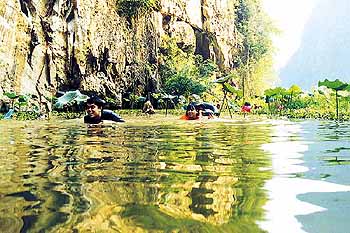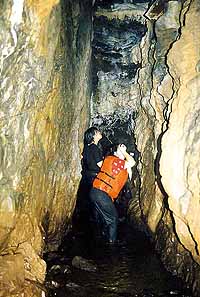Off The Beaten Track
Limestone wonders
By Dr. Chan Ah Lak
Pictures by Yoon Lai Wan
TRAMP through a grassy marsh, swim 100m through a lotus pond, wade 1,000m in a pitch-dark tunnel, hike 100m, crawl single file in a serpentine cave against the current of a small stream and finally scramble up two waterfalls to reach your target. . . . Is this a new decathlon event?
No, just the setting for our recent Six Mile Tunnel adventure, organised by the Perak Branch of the Malaysian Nature Society (MNS). Caving coordinator Chang Kok Kai led us, a contingent of 36, to one of the limestone hills in the Kinta Valley.
Participants came well prepared with floats, tyre tubes and life jackets. They had been briefed two weeks earlier by MNS Perak vice-president Ng Chang Chai on the rigours of the trip.

It is a 100-metre wade across for MNS (Perak) members through this lotus pond of the limestone hills in Kinta Valley. |
Then we came upon the lotus pond. The 100m swim across it was tiring as we had to tow floats with our food, torchlight, cameras. Mercifully we encountered only a few spiky lotus stems.
The non-swimmers had to be pushed and pulled along. From a distance, we must have looked like a convoy of multi-coloured ships with accompanying tug boats as we made our way to the tunnel's entrance.
Tough though it was, we noticed some King's Begonia (Begonia kingianai), with their tortoise-like leaves, growing precariously on the vertical limestone walls. In the shallow parts of the pond, we could feel freshwater mussels underfoot.
At last, the half submerged entrance of the tunnel beckoned us. Initially, the water level was chest-deep but it gradually subsided to ankle level. The headroom was claustrophobic at first and we had to crouch, but soon we could walk erect easily. There were limestone formations and also a chamber inhabited by bats. A small waterfall here broke the monotony of the hike. Maybe there was an exit higher up but we were not equipped to explore it.

This cave is some one-kilometre long but the miners of old named it the Six Mile Tunnel. MNS members take a closer look at its walls. |
The "wang" seemed a haven for all sorts of ginger plants -- Torch Ginger (bunga kantan, Phaeomeria speciosa), Scarlet Earth Ginger (Achasma megalocheilos) and Yellow Earth Ginger (Achasma macrocheilos). They were all in bloom as if to welcome us.
Here too Begonias adorned the surrounding limestone cliffs. An unusual gesneriad with small white flowers invited us to inspect it. According to some MNS veterans, the kilometre-long tunnel was the result of miners excavating a tin ore-rich vein; the lake and pond were abandoned mining pools. It helped explained the stacks of stones.
In the olden days, miners used candles to find their way through the tunnel. To them the tunnel appeared to be six-mile long, hence the name.
A 100m hike through the garden led to a three-metre high cave opening with ice cold water flowing out. A 10m belly crawl brought us to the first of three waterfall inside this cave. Scaling down and then crawling another 10m brought us to the second.
This two-metre high waterfall is a nightmare to cavers. It is almost vertical, the sides are smooth marble, and there is only one foothold. The long-legged ones managed to clamber up with some effort, while the short ones needed a leg-up and a helping hand.
A couple of bends and twists of the body took us to the third waterfall. The passage was very narrow here and we did not attempt to proceed further.
After enjoying the cold shower for a while, we made an equally arduous return journey. It had been a tiring trip but we felt a sense of achievement.
We had experienced a most unusual and challenging MNS adventure.
For those who are interested in nature appreciation trips like hiking, camping, cave exploration, marine trips and bird watching, contact:
Malaysian Nature Society, Perak Branch,
Ipoh Garden Post Office Box 34,
31407 Ipoh, Perak.
Tel: 05-3128716
Webpage: http://www.lumutport.com/mns/
Email: [email protected]